Kategorie: ‘Listening Effort’
Paper published: The influence of complex classroom noise on auditory selective attention
We are very glad to share that our paper “The influence of complex classroom noise on auditory selective attention”, based on the bachelor’s thesis of Robert Schmitt, which we co-authored, has just been published in Scientific Reports: https://www.nature.com/articles/s41598-025-18232-2
It has been a real pleasure to supervise this work and to see it evolve into a full publication. In the study, we examined how plausible classroom noise affects auditory selective attention in a virtual reality classroom environment.
Our results underline the importance of studying realistic and complex acoustic scenarios to gain more reliable and valid insights into auditory perception by showing higher error rates in the auditory attention task under complex noise conditions, as well as an increased perceived listening effort when the background contained intelligible speech.
The paper was developed within the ECoClass-VR project, part of the DFG Priority Program SPP 2236 AUDICTIVE on Auditory Cognition in Interactive Virtual Environments. More information at www.spp2236-audictive.de.
We hope these findings contribute to advancing our understanding of auditory attention in complex, real-world listening situations.
Many thanks to the co-authors Robert Schmitt, Larissa Leist, Stephan Fremerey, Alexander Raake, Maria Klatte, and Janina Fels, and to the AUDICTIVE community for the inspiring collaboration and support.
Janina Fels und Cosima Ermert beim „International Symposium on Auditory and Audiological Research – ISAAR 2025“
Vom 19. bis 22. August 2025 reisten Janina Fels und Cosima Ermert nach Dänemark, um das „International Symposium on Auditory and Audiological Research – ISAAR 2025“ in Nyborg zu besuchen.
Janina Fels hielt einen eingeladenen Vortrag zum Thema „Exploring Auditory Cognition: Connecting Real-World Contexts with Interactive Virtual Environments” und stellte dabei mehrere laufende Forschungsvorhaben vor, die sich speziell mit selektiver auditiver Aufmerksamkeit und Höranstrengung (Listening Effort) bei Kindern in Klassenräumen unter realistischen Hörbedingungen befassen.
Cosima Antonia Ermert präsentierte dazu ein Poster mit dem Titel „Listening Effort in Populated Audiovisual Scenes Under Plausible Room Acoustic Conditions”.
Einen Tag vor der ISAAR reiste Janina Fels zum „Pre-ISAAR Mini-Symposium“ beim Eriksholm Research Centre. Sie hatte die Gelegenheit, mehr über aktuelle Themen und Projekte zu erfahren und diese ausführlich zu diskutieren. Es fand eine exzellente Führung durch die Labore statt und es wurden zahlreiche hochinteressante Posterpräsentationen abgehalten. Zudem wurden eine Vielzahl neuer Ideen für zukünftige Kooperationen diskutiert.
Währenddessen nahm Cosima Ermert am „Workshop in Communication in Hearing Science” von WS Audiology teil. Dieser Workshop beschäftigte sich mit dem Thema „Understanding how noise and hearing impairment affect communication”. Cosima präsentierte für das IHTA ein Poster mit dem Titel „Bringing real-life into the lab: Investigating speech in virtual auditory environments – which aspects contribute to a plausible simulated conversational situation?”.
Paper published: Activity-based acoustic situations in primary schools
We are happy to share a new publication by Julia Seitz and Janina Fels. Their journal paper „Activity-based acoustic situations in primary schools: Analyzing classroom noise and listening effort“ was published in the Journal of the Acoustical Society of America.
The publication introduces the concept of „activity-based acoustic situations“ in primary schools, shedding light on the everyday sound environment in classrooms.
Key findings include that different classroom activities result in significantly different noise levels, that noise levels decrease as students age—first graders experience higher levels than fourth graders—and that subjective listening effort does not differ significantly between activities. The results highlight the importance of activity-based assessment of classroom noise to create optimal learning environments.
Paper published: Listening effort in children and adults in classroom noise
We are happy to share the publication of our journal paper „Listening effort in children and adults in classroom noise“ in Scientific Reports as part of the Auditory processing and perception collection!
Julia Seitz, Karin Loh, and Janina Fels conducted a study to investigate listening effort in children aged 6-10 years and young adults using a child-appropriate dual-task paradigm. Realistic classroom scenarios with multi-talker babble noise at different signal-to-noise ratios in anechoic and simulated classroom environments were investigated.
The key findings
• Found differences in listening effort between noise conditions in 8-10-year-olds
• Demonstrated the importance of considering room effects in listening experiments
• Observed correlations between subjective and behavioral measures of listening effort
This research contributes to our understanding of how children process speech in noisy classroom environments and could help to improve learning conditions.





